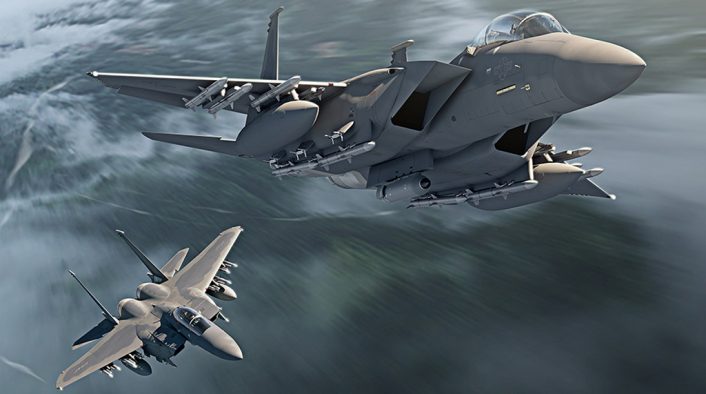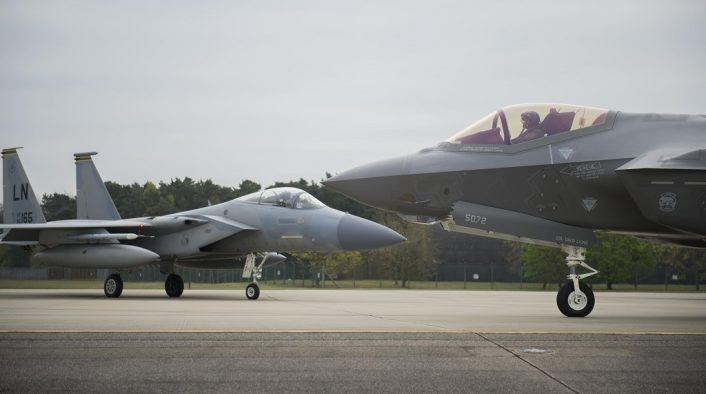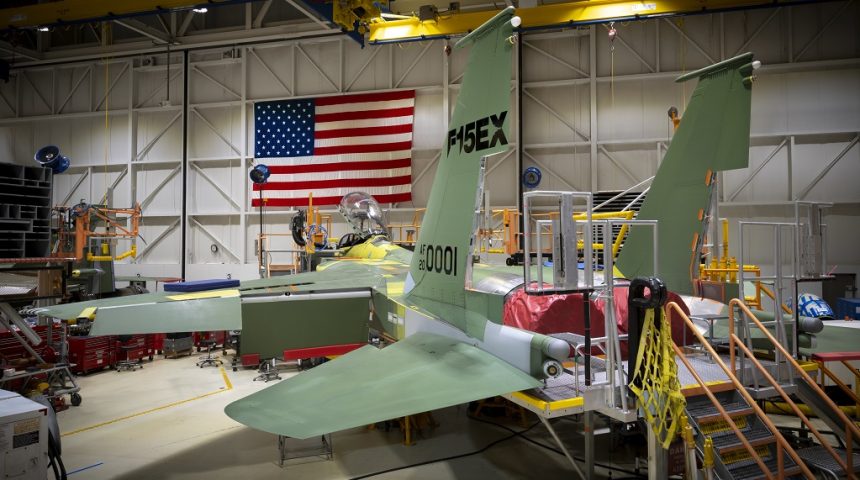The new Eagles will refresh the aging F-15C fleet and will complement the F-35.
The Department of the Air Force and Boeing signed a deal worth USD 1.2 billion for the first lot of eight F-15EX jets that will be delivered to Eglin Air Force Base, Florida, to be thoroughly tested before starting to replace the oldest F-15Cs and F-15Ds in the U.S. Air Force fleet.
According to the official statement, the first two aircraft, which are already being built, will be delivered during the second quarter of 2021, while the remaining aircraft will be delivered in 2023. The Air Force is planning to buy 76 F-15EX aircraft over the five-year Future Years Defense Program, a number that could eventually increase up to 144 aircraft. Other than the first lot of eight F-15EX, a second lot of 12 aircraft has already been requested for next year’s budget.
The new F-15EX, developed from the F-15QA that is currently the most advanced Eagle variant, comes from a series of needs mainly emerged after the National Defense Strategy directed the U.S. armed services to adapt to the new threats from China and Russia. The most burdensome requirement is the need for the Air Force to add 74 new squadrons to the current 312 squadrons, reaching a total of 386 by 2030. This obviously means more aircraft.
The Air Force needs also to lower the average aircraft age down from 28 years to 15 years without losing any capacity, as explained by the General David Goldfein, Air Force Chief of Staff, last year to DefenseNews. To reach the objectives, the Air Force would need 72 new fighters every year, but the budget wouldn’t be enough for them to be all F-35s, so the next best thing is refreshing the F-15C fleet before it reaches the end of its service life, making sure that the 4th generation and 5th generation aircraft will complement each other, as said also by Gen. Mike Holmes, commander of Air Combat Command, for the F-15EX contract award: “The F-15EX is the most affordable and immediate way to refresh the capacity and update the capabilities provided by our aging F-15C/D fleets. The F-15EX is ready to fight as soon as it comes off the line.”

Like the F-15QA Qatar Advanced, the F-15EX is a two-seat aircraft but with some added US-only capabilities. It will feature new outer wing hardpoints for increased payload, AN/APG-82(V)1 Advanced Electronically Scanned Array (AESA) radar, Joint Helmet-Mounted Cueing Systems (JHMCS) for both the pilot and the Weapon Systems Officer (WSO), 10×19-in Large Area Displays (LADs) and low-profile Head-Up Display (HUD) in both cockpits, digital fly-by-wire, General Electric F110-GE-129 engines, the new Eagle Passive Active Warning Survivability System (EPAWSS) electronic warfare and electronic surveillance system, the Legion Pod InfraRed Search and Track system (IRST) and the latest mission systems and software capabilities available for legacy F-15s.
According to the Air Force, “the most significant difference between the F-15EX and legacy F-15s lies in its Open Mission Systems (OMS) architecture. The OMS architecture will enable the rapid insertion of the latest aircraft technologies.”
The EPAWSS, developed by BAE systems, is a new generation Electronic Warfare (EW) system that will be retrofitted also on the current F-15 fleet. In April, an F-15E Strike Eagle equipped with the new system was undergoing testing at the Benefield Anechoic Facility that will also check the compatibility with the AN/APG-82 radar. Here is a brief description of EPAWSS provided by the USAF:
The EPAWSS is designed to provide indication, type and position of ground-based RF threats as well as bearing of airborne threats with the situational awareness needed to avoid, engage or negate the threat. The EPAWSS defends against RF and IR threat systems detecting or acquiring accurate targeting information prior to threat engagement thus complicating and/or negating an enemy threat targeting solution. The system counters threats through its suite of components with electro optical and RF techniques.
The IRST-equipped Legion Pod recently hit two major milestones at Eglin AFB, with the first AIM-9X IR-guided air-to-air missile shot from an F-15C Eagle using the Legion Pod for targeting on July 8 and the first-ever flight of an operational F-16 Fighting Falcon with the Legion Pod on the 5R chin station (usually occupied by Sniper or Litening Targeting Pods) on July 13. As stated by the Air Force, “use of the Legion Pod and its IRST capabilities allows a pilot to have another sensor that integrates with the aircraft and builds a more complete picture of the battlespace. Because of its use of infrared, it provides the ability to identify, track and shoot enemy aircraft in a RADAR jamming environment to include stealth aircraft that a traditional radar may not see.”

Regarding the engines, the Air Force awarded General Electric a contract for a first lot of engines that includes 19 F110-GE-129A 29400-pound thrust engines, of which 16 will be installed on the aircraft and three will be spares. According to the Air Force Materiel Command, the engine directorate “used a 20 percent factor for spare engines.” Initially the Air Force planned to award sole-source contracts to General Electric for 461 engines that would power the 144 F-15EXs, in an effort to speed up the program.
However, Pratt & Whitney protested and the Air Force responded that will hold an open competition if the company certifies the F100 engine, most probably in the F100-PW-229 29160-pound thrust variant used on late model F-16s and F-15Es, at its own expense on the F-15EX.
With the new outer wing hardpoints and new weapon racks, the F-15EX will be able to carry a way higher payload than its predecessor, with up 22 air-to-air missiles in air-to-air configuration. An interesting detail was provided also by Boeing in the news release: “The F-15EX […] can launch hypersonic weapons up to 22 feet long and weighing up to 7,000 pounds.” Boeing also showed a representative model of a hypersonic missile under the centerline hardpoint of the F-15EX at the Air Warfare Symposium in February, as shown in the tweet below:
Boeing, by the way, displayed this representative model of a 7,300lb hypersonic missile on an F-15EX at the Air Warfare Symposium in February. I’m getting the impression they’re trying to subtly tell us something. pic.twitter.com/kfJ5nPYHzF
— Steve Trimble (@TheDEWLine) July 13, 2020
Another important feature of the F-15EX program is the fast transition from the legacy Eagle, as said by Gen. Holmes: “When delivered, we expect bases currently operating the F-15 to transition to the new EX platform in a matter of months versus years”. Gen. David A. Krumm, at the time Director of Strategic Plans and Requirements, explained in 2019 that the two aircraft share a “80-90 percent commonality”, with the F-15EX being able to use all the ground equipment of the -C variant, and the transition will take “less than six months” instead of the usual 18 months for an active duty unit or three years of an Air National Guard unit.









